Performing Aircraft Mission Planning Using Analyzer
STK Premium (Air) or STK Enterprise
You can obtain the necessary licenses for this tutorial by contacting AGI Support at support@agi.com or 1-800-924-7244.
Required product install: A 64-bit version of Java is required to run Analyzer. See the Analyzer system requirements for more information.
This lesson requires STK 12.2 or newer to complete it in its entirety. It includes new features introduced in STK 12.2.
The results of the tutorial may vary depending on the user settings and data enabled (online operations, terrain server, dynamic Earth data, etc.). It is acceptable to have different results.
Capabilities covered
This lesson requires the following capabilities:
-
STK Pro
-
Aviator
-
STK Analyzer
Problem statement
Aircrew and mission planners require a quick way to determine how wind will affect an aircraft's fuel consumption for a planned flight route. A military turboprop aircraft will: take off from an airfield in England, climb to an altitude of 20,000 feet MSL (mean sea level), navigate over three navigational aids (Navaids) in France, and then land at a base located in Germany.
The aircraft has a fuel capacity of 200,000 pounds but will take off with 100,000 pounds of fuel. In total, the aircraft's weight with fuel is 380,000 pounds. The maximum landing weight is also 380,000 pounds.
A weather system is moving into the area of the aircraft's planned flight route. Winds are predicted to change heading The direction that the aircraft is pointing. with variable speeds up to 25 nautical miles-per-hour. The aircraft is rated to land with a cross wind up to 30 nautical miles-per-hour, so you should not factor the cross wind into the problem.
Your goal: determine how much fuel needs to be loaded on the aircraft prior to takeoff based on the worst case scenario. Use STK and STK's Analyzer capability to determine how wind speed and wind direction will affect how much fuel is consumed during the mission.
What you will learn
Upon completion of this tutorial, you will understand how to:
- Change wind bearing and speed
- Run parametric studies
- Create carpet plots
- Sync data from Analyzer to STK
Video Guidance
Watch the following video. Then follow the steps below, which incorporate the systems and missions you work on (sample inputs provided).
Please note, the video refers to a starter scenario accessed from the STK Data Federate (SDF). This scenario is included with your STK install. Please follow the written steps in this tutorial to open the file.
Using a starter scenario
A partially created scenario has been created for you to enable you to focus on the portion of this exercise that teaches you how to use Analyzer and Aviator
Loading the starter scenario
The STK scenario (VDF) used with this tutorial is included with the STK installation. To open the scenario:
- Launch the STK® (
 ) application.
) application. - Click in the Welcome to STK dialog box.
- Browse to <Install Dir>\Data\Resources\stktraining\VDFs.
Opening the VDF
- Select Aviator_Analyzer_Starter.vdf.
- Click .
Saving the starter scenario as a SC file
When you open the scenario, a directory with the same name as the scenario will be created in the default user directory (e.g. C:\Users\<username>\Documents\STK_ODTK 13). The scenario will not be saved automatically. When you save a scenario in STK, it will save in the format in which it originated. In other words, if you open a Visual Data File (VDF), the default save format will be a VDF. The same is true for a scenario file (*.sc). If you want to save a VDF as an SC file (or vice-versa), you must change the file format when you are performing the Save As procedure.
- Open the File menu.
- Select Save As...
- Select the STK User folder in the navigation pane when the Save As dialog box opens.
- Select the Aviator_Analyzer_Starter folder.
- Click .
- Change Save as type: to Scenario Files (*.sc).
- Click .
- Click to confirm.
Save Often!
Obtain situational awareness
Use STK's 3D and 2D Graphics windows to visualize and understand the aircraft flight plan.
- Zoom To TurboProp (
 ).
). - Look at the 3D Graphics window.
- Click Start (
 ) in the Animation Toolbar to obtain situational awareness of TurboProp's (
) in the Animation Toolbar to obtain situational awareness of TurboProp's ( ) takeoff and location. An articulation file is being used to spin the propellers.
) takeoff and location. An articulation file is being used to spin the propellers. - Reset (
 ) the scenario after you have watched the animation.
) the scenario after you have watched the animation. - Look at the 2D Graphics window to obtain the overall view of the flight plan.
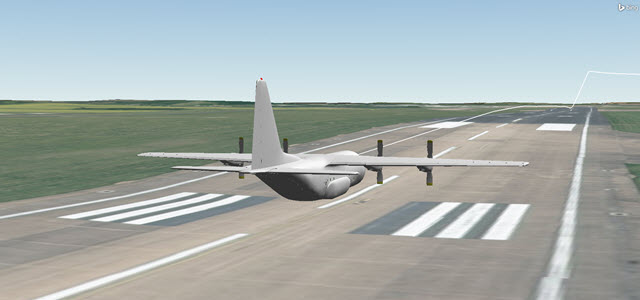
TurboProp Taking Off from English Airbase
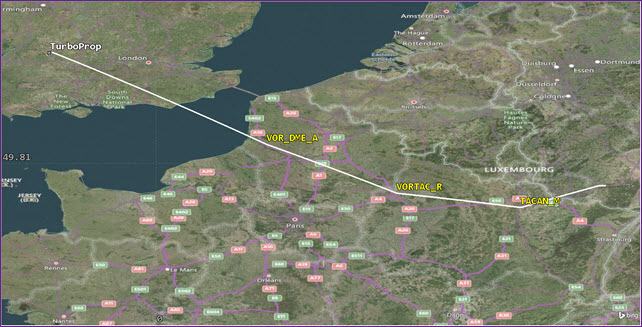
TurboProp's Flight Plan
Aircraft configuration
Before using Analyzer to run trade studies, it's a good idea to understand the variables which will be changed and analyzed to determine how much fuel is consumed during the flight.
- Right click on TurboProp (
 ) in the Object Browser.
) in the Object Browser. - Select properties (
 ).
). - Click Configuration (
 ) in the Initial Aircraft Setup toolbar.
) in the Initial Aircraft Setup toolbar. - Ensure the Basic tab is selected.
- Select the Fuel tab.
- Click to close the Aircraft Configuration window.
TurboProp's (![]() ) propagator is set to Aviator. Aviator models real-world aircraft performance that accounts for variations in airframe performance characteristics, wind, atmospheric effects, and mission requirements.
) propagator is set to Aviator. Aviator models real-world aircraft performance that accounts for variations in airframe performance characteristics, wind, atmospheric effects, and mission requirements.
Note the Empty Weight:, Max Landing Weight:, and Total Weight.
The aircraft has a capacity of 200,000 pounds of fuel but is taking off with 100,000 pounds of fuel.
Winds
Wind bearing and speed will affect the aircraft's performance characteristics.
- Click Mission Wind Model (
 ) in the Initial Aircraft Setup toolbar.
) in the Initial Aircraft Setup toolbar. - Click to close the Wind and Atmosphere Model tool.
- Click to close TurboProp's (
 ) properties.
) properties.
Wind Bearing (0 degrees) and Wind Speed (10 nautical miles per hour) will be changed and analyzed to determine their affect on fuel consumed.
STK Analyzer
STK Analyzer provides a set of analysis tools that:
- Enable you to understand the design space of your systems.
- Enable you to perform analyses in STK easily without involving programming or scripting.
- Introduce trade study and post-processing capabilities.
- Can be used with all STK scenarios.
- Open the View menu.
- Navigate from Toolbars > Analyzer.
- Select Analyzer.
- Click Analyzer (
 ) on the Analyzer toolbar.
) on the Analyzer toolbar.
Another way of opening Analyzer is to open the Analysis menu, select Analyzer and then click the Analyzer button. One more way opening Analyzer is to go to the Object Browser, right click on the scenario object (or any object), select the object's Plugins, and click Analyzer.
Analyzer layout
You can use the Analyzer Main Form to configure input/output variables available for further analysis. You can first select an object in the STK Variables tree on the left. When an object is selected, all possible input variable candidates are listed under the STK Property Variables - General tab and the Active Constraints tab. All output variable candidates are listed under the Data Provider Variables - Data Providers tab and Object Coverage tab.
Determine the impact of wind bearing on fuel consumed
The first study you will perform varies wind bearing to determine its effects on how much fuel is used during the mission. The current wind speed of ten (10) nautical miles per hour will be maintained. You need to select input and output variables from the main Analyzer window to pass to the Parametric Study tool.
Start by selecting wind bearing as the input variable.
- Select TurboProp (
 ) in the STK Variables tree.
) in the STK Variables tree. - Expand (
 ) Propagator (Aviator) in the STK Property Variables - General tab.
) Propagator (Aviator) in the STK Property Variables - General tab. - Expand (
 ) WindModel (Constant Wind).
) WindModel (Constant Wind). - Double-click on WindBearing. This moves it to the Analyzer Variables field as an input.
Choose outputs
The same data providers that are in the Report & Graph Manager are available in the Data Provider Variables list.
- Expand (
 ) Flight Profile By Time in the Data Provider Variables - Data Providers list.
) Flight Profile By Time in the Data Provider Variables - Data Providers list. - Expand Fuel Consumed.
- Double-click on Max. This moves it to the Analyzer Variables field as an output.
Parametric Study tool
Use the Parametric Study Tool to run a model through a sweep of values for some input variable. The resulting data can be plotted to view trends.
- Click Parametric Study (
 ) on the Analyzer toolbar to access the Parametric Study Tool.
) on the Analyzer toolbar to access the Parametric Study Tool. - Drag and drop the WindBearing variable from the Component Tree (left) to the Design Variable field (right).
- Set the following:
- Drag the Max variable from the components list and drop it into the Responses field.
- Click . STK will perform the calculations and build a 2D scatter plot.
- Bring the Table - Trade Study 1 - Data Explorer window (Table Page) to the front.
To perform a Parametric Study, one design variable and one or more responses must be specified. For the design variable, a starting value, ending value, and either number of samples or number of steps must also be specified. To select variables, drag them from the Component Tree on the left and drop them into the Parametric Study Tool on the right.
The current wind bearing is zero (0) degrees. For the purposes of this trade study, vary the heading from zero (0) degrees to 180 degrees in 20 degree increments. Ten (10) runs (scenario changes) will be required to analyze your variable.
| Option | Value |
|---|---|
| starting value: | 0 |
| ending value: | 180 |
| step size: | 20 |
The Data Explorer is a tool used by Trade Study tools to display data while they are being collected from STK. While data is being collected, the Data Explorer displays a progress meter, a halt button, and the data.
Table page
The Table page displays trade study data in a tabular form. It is the default window that is present for all trade studies. Cells are shaded differently depending on the associated variable's state. Input variables are shown with green text, valid values are displayed with black text, invalid values are displayed with gray text, and modified values are displayed with blue text. From the table it is possible to view and edit all values in your trade study and even to add and remove whole runs.
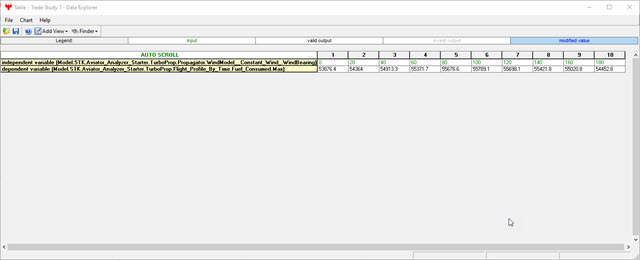
Table Page
The first line shows wind bearing from zero (0) degrees through 180 degrees. The second line shows the maximum fuel consumed.
Once the trade study is complete and all data has been collected, the Data Explorer toolbar becomes active. Some trade study tools will automatically launch a default plot window when the trade study runs. There are multiple views that can be selected to visualize the data seen on the Table Page. You can choose views by selecting from the Add View drop down menu.
2D Scatter Plot
Analyze the data.
- Bring the 2D scatter plot to the front
- Place your cursor on the point that shows the maximum fuel consumed. A small window with information appears.
- Click the ellipsis (
 ) in the small information window that appears at the maximum fuel consumed. This opens the design view which shows you complete values for the point.
) in the small information window that appears at the maximum fuel consumed. This opens the design view which shows you complete values for the point. - When finished, close the Design View.
- Close the 2D scatter plot and the Table Page.
- Select when the Save window appears.
- Close the Parametric Study.
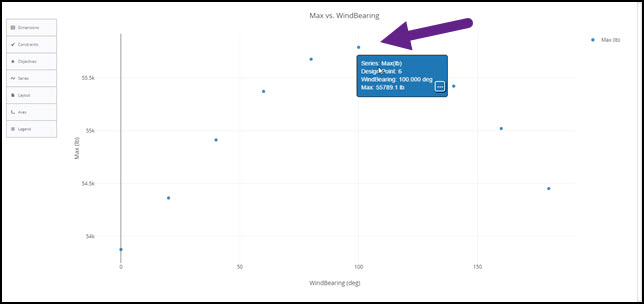
Wind Bearing vs Maximum Fuel Consumed

Design View
Determine the impact of wind speed on fuel consumed
Wind speed will have an obvious impact with a constant wind bearing.
- Return to Analyzer.
- Select TurboProp (
 ) in the STK Variables tree.
) in the STK Variables tree. - Expand (
 ) Propagator (Aviator) in the STK Property Variables - General tab.
) Propagator (Aviator) in the STK Property Variables - General tab. - Expand (
 ) WindModel (Constant Wind).
) WindModel (Constant Wind). - Double click on WindSpeed. This moves it to the Analyzer Variables field as an input.
- Click Parametric Study (
 ) on the Analyzer toolbar.
) on the Analyzer toolbar.
Change wind bearing value and sync to STK
Recall that the most fuel consumed with a wind speed of ten (10) nautical miles per hour was a wind bearing of 100 degrees. In the Parametric Study Tool Component Tree, you can change the wind bearing value and sync it to STK. You'll change wind speed using the bearing that reported the most fuel consumed (worst case scenario).
- Click the WindBearing variable in the Component Tree.
- Change the value to 100 (degrees).
- Click at the bottom of the Component Tree. You'll see the Fuel_Comsumed Max value in the Component Tree change after the sync is complete.
- Save (
 ) the scenario in STK.
) the scenario in STK. - Return to the Parametric Study Tool.
- Drag and drop the WindSpeed variable from the Component Tree (left) to the Design Variable field (right).
- Set the following:
- Drag and drop the Max variable into the Responses field.
- Click .
| Option | Value |
|---|---|
| starting value: | 0 |
| ending value: | 25 |
| step size: | 5 |
Wind speed results
Looking at the 2D Scatter Plot, there are no real surprises. There's a steady increase in fuel consumed with an increase in wind speed. What's interesting to note is how much of a difference there is between zero nautical miles per hour and twenty-five nautical miles per hour. The difference is over 4500 pounds of fuel consumed.
Wind Speed vs Fuel Consumed
- Close the 2D Scatter Plot and the Table Page.
- Select when the Save window appears.
- Close the Parametric Study.
- Return to Analyzer.
Carpet Plot tool
A Carpet Plot is a means of displaying data dependent on two variables in a format that makes interpretation easier than normal multiple curve plots. A Carpet Plot can be thought of as a multi-dimensional Parametric Study.
You can set the design variables for Carpet Plot in a similar way to the Parametric Study Tool, except you now have two variables instead of one. We know that wind bearing and wind speed had an impact on fuel consumed. For the purposes of this study, keep the number of steps low for time. However, on your own, you can run as many runs as you desire.
- Click Carpet Plot (
 ) on the Analyzer toolbar to access the Carpet Plot Tool.
) on the Analyzer toolbar to access the Carpet Plot Tool. - Drag the WindBearing variable to the first Design Variable field on the right.
- Set the following WindBearing Design Variables:
- Drag the WindSpeed variable to the second Design Variable field.
- Set the following WindSpeed Design Variables:
- Drag and drop the Max response into the Responses field.
- Click . STK will run 20 times. This could take a few minutes.
| Option | Value |
|---|---|
| From | 99 |
| To | 101 |
| Step Size | .5 |
| Option | Value |
|---|---|
| From | 10 |
| To | 25 |
| Step Size | 5 |
Refined results
An earlier trade study analysis resulted in the most fuel consumed when the wind bearing was at 100 degrees. Using the carpet plot, you refined this by focusing on 99 through 101 degrees using 0.5 degree increments.
Carpet Plot axes
Use the Carpet Plot Axes tab to set options for the axes.
- Bring the Carpet Plot to the front.
- Click on the left.
- Select the tab.
- Change the Max # value to 40.
- Click anywhere on the plot to close the Axes menu.
- Click . You can constrain the carpet plot for better visualization when looking for specific variable data.
- Set the WindBearing minimum value to 100.
- Set the WindSpeed minimum value to 19.
- Click on the Carpet Plot to close the constraints view.
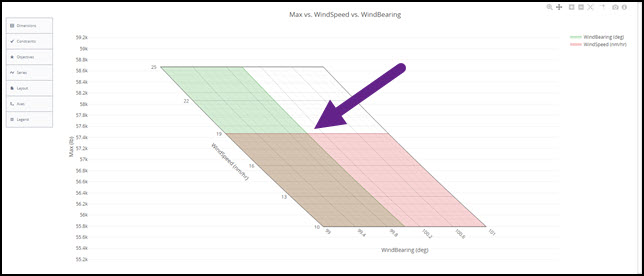
Carpet Plot Constraints View
Looking at the Carpet Plot, where the two minimum values meet shows the maximum fuel consumed.
Wrapping up the scenario
- When finished, close the Carpet Plot and the Table Page.
- Select when the Save window appears.
- Close the Carpet Plot Tool.
- Close Analyzer.
- Click Save (
 ).
).
Summary
An aircraft mission was scheduled to fly from an airfield in England and land at an airfield in Germany. The weather forecast in the area called for variable wind speed and bearing. A large, pre-configured turboprop aircraft and it's flight plan were already loaded into STK using Aviator. You used Analyzer to run Parametric Trade Studies which determined fuel consumed based on changing wind bearing and increasing wind speed. You used a Carpet Plot to evaluate wind speed versus wind bearing to determine the worst case scenario of the mission which will help you to ensure there was enough fuel on board the aircraft prior to take off.
On Your Own
Throughout the tutorial, hyperlinks were provided that pointed to in depth information of various tools and functions. Now's a good time to go back through this tutorial and view that information. You could rerun all the Parametric studies using new values with the existing input variables. There are a lot of combinations you could try. Explore and have fun!